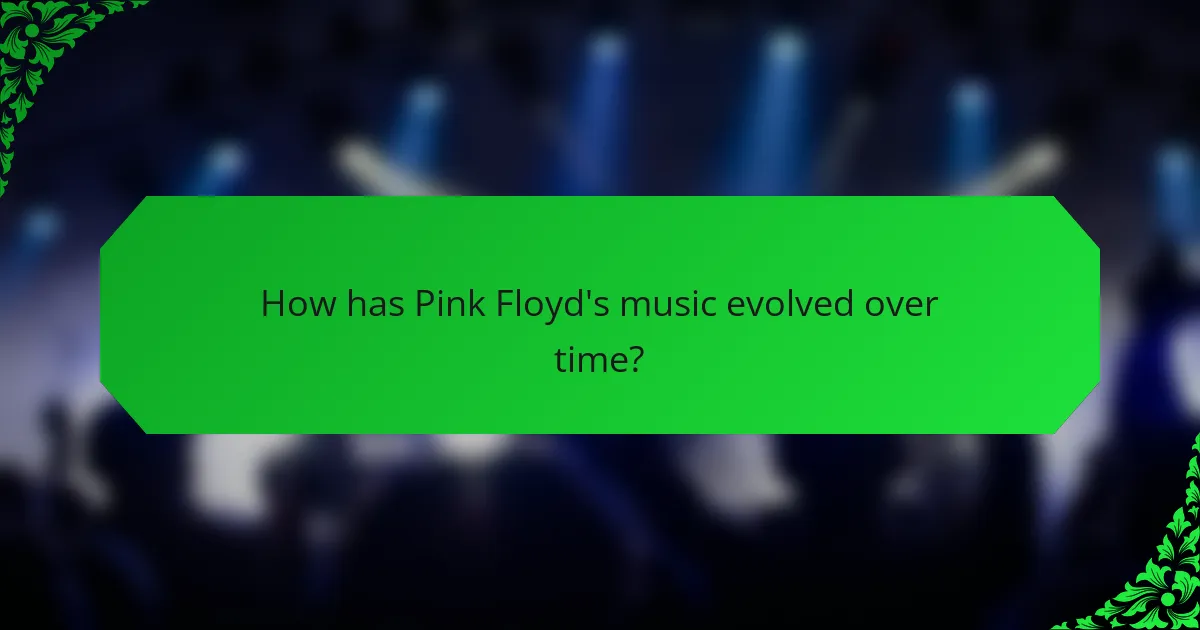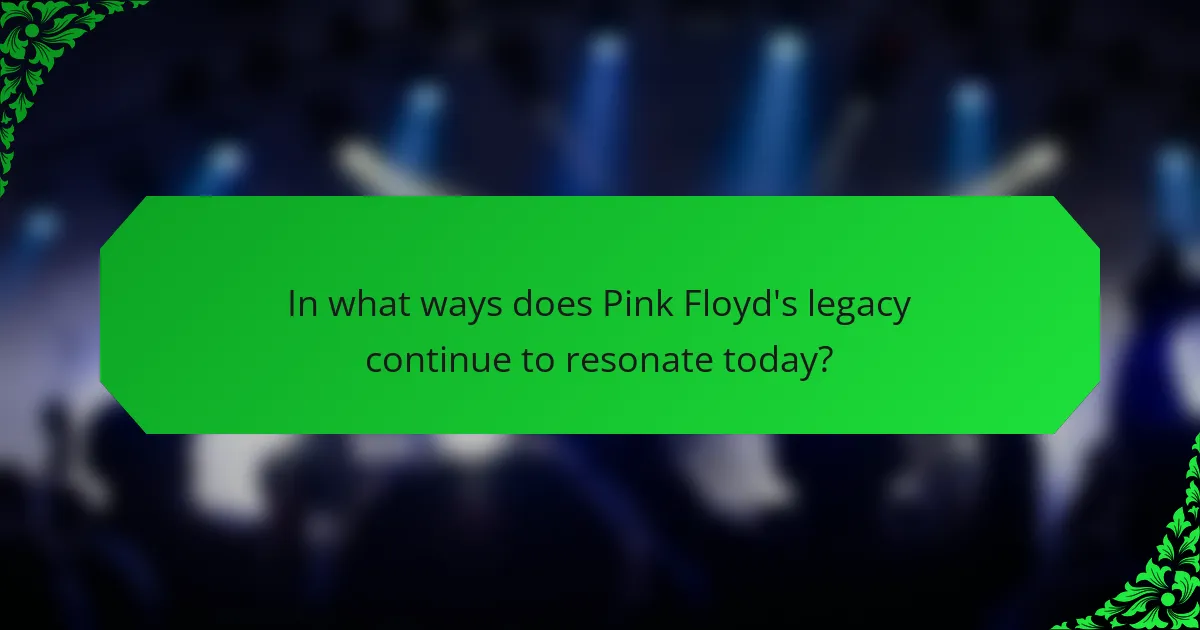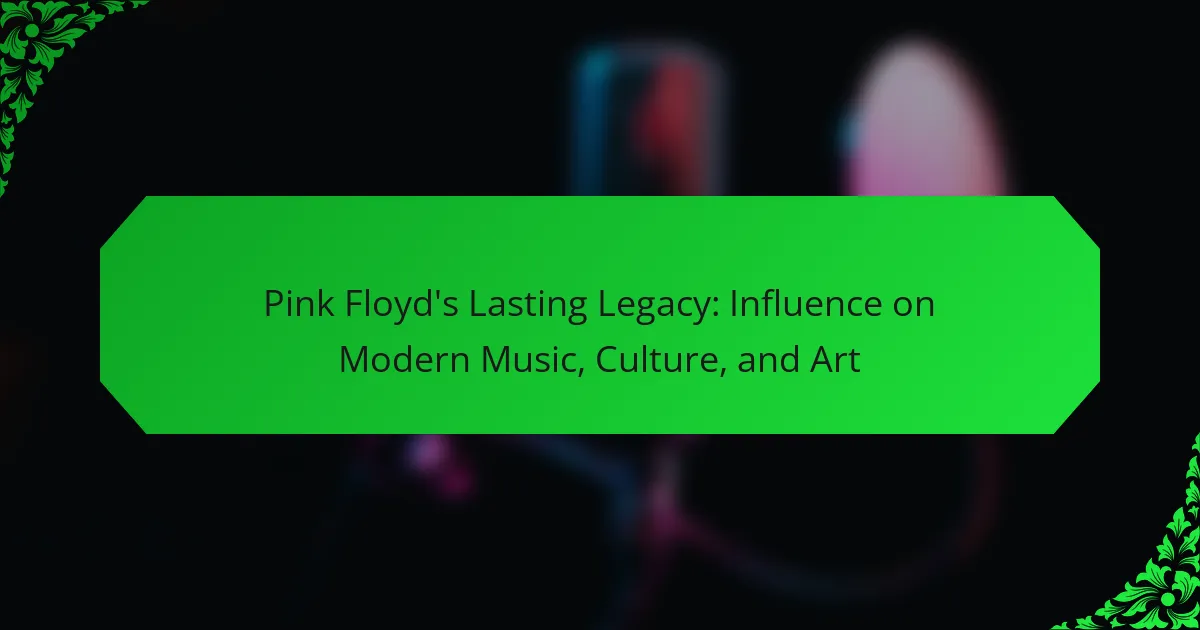Pink Floyd is a seminal rock band known for their profound influence on modern music, culture, and art. The band revolutionized the album format, transforming it into an artistic statement through innovative sound, lyrics, and visual elements. Key albums such as “The Dark Side of the Moon” and “The Wall” showcase their exploration of complex themes, including mental health and societal issues, which continue to resonate today. Their elaborate live performances and multimedia integration have set a standard for concert experiences, while their music and iconic album covers remain influential across various genres. Pink Floyd’s legacy is evident in the evolution of progressive rock and their lasting impact on contemporary artistic expression.

What is Pink Floyd’s Lasting Legacy?
Pink Floyd’s lasting legacy is their profound influence on modern music, culture, and art. The band revolutionized the concept of the album as an artistic statement. Their innovative use of sound, lyrics, and visual elements set a new standard for musical storytelling. Albums like “The Dark Side of the Moon” and “The Wall” have become cultural touchstones. They are known for their elaborate live shows, integrating multimedia and theatrical elements. Pink Floyd’s exploration of complex themes, such as mental health and societal issues, resonates with audiences today. Their music continues to inspire countless artists across various genres. The band’s impact is evident in the evolution of progressive rock and beyond.
How has Pink Floyd influenced modern music?
Pink Floyd has significantly influenced modern music through their innovative use of sound and concept albums. Their album “The Dark Side of the Moon” introduced seamless transitions between tracks, impacting album structure. This approach has inspired countless artists to prioritize cohesive storytelling in their work. The band’s incorporation of experimental sounds, such as synthesizers and tape loops, set a precedent for electronic music. Their thematic exploration of existentialism and mental health resonates in contemporary lyrics. Pink Floyd’s emphasis on visual elements in live performances has influenced concert production standards. The band’s legacy is evident in genres ranging from progressive rock to alternative and electronic music. Artists like Radiohead and Muse cite Pink Floyd as a key inspiration in their musical development.
What specific genres have been shaped by Pink Floyd’s sound?
Progressive rock, psychedelic rock, and art rock are specific genres shaped by Pink Floyd’s sound. Their innovative use of soundscapes and concept albums set a precedent in progressive rock. The band’s exploration of themes like alienation and existentialism influenced the lyrical depth in psychedelic rock. Pink Floyd’s incorporation of visual elements in live performances contributed to the art rock genre’s development. Their album “The Dark Side of the Moon” is a landmark in music history, solidifying the band’s impact on these genres.
Which contemporary artists cite Pink Floyd as an influence?
Contemporary artists who cite Pink Floyd as an influence include Radiohead, The Smashing Pumpkins, and Tame Impala. Radiohead’s sound often reflects Pink Floyd’s experimental approach. The band’s album “OK Computer” shows similarities in thematic depth. The Smashing Pumpkins have expressed admiration for Pink Floyd’s sonic landscapes. Their album “Mellon Collie and the Infinite Sadness” features progressive rock elements. Tame Impala’s psychedelic sound draws inspiration from Pink Floyd’s “The Dark Side of the Moon.” These artists acknowledge Pink Floyd’s impact on their music and creative direction.
What impact has Pink Floyd had on popular culture?
Pink Floyd has profoundly influenced popular culture through their innovative music and visual artistry. Their album “The Dark Side of the Moon” is one of the best-selling albums of all time, showcasing their impact on music sales and consumption. The band’s use of concept albums changed the music industry, encouraging artists to create cohesive, thematic works. Pink Floyd’s elaborate live performances set new standards for concert experiences, integrating light shows and multimedia elements. Their exploration of themes like mental health and societal issues resonated with listeners, influencing countless artists across genres. The band’s iconic imagery, such as the prism on the “Dark Side of the Moon” cover, has become a cultural symbol. Their music has been featured in films and advertisements, further embedding their work in popular culture. Overall, Pink Floyd’s contributions have shaped the landscape of modern music and art significantly.
How has Pink Floyd’s imagery permeated visual arts?
Pink Floyd’s imagery has significantly influenced visual arts through its iconic album covers and stage designs. The band’s collaboration with graphic designer Storm Thorgerson resulted in memorable visuals. The cover of “The Dark Side of the Moon” became a symbol of psychedelic art. Artists like Damien Hirst and Banksy have referenced Pink Floyd’s themes in their work. The band’s use of surrealism and abstract concepts resonates with contemporary visual artists. Their live performances incorporated elaborate visual effects, inspiring multimedia art. This integration of music and visual arts continues to inspire new generations of artists.
What role has Pink Floyd played in film and media?
Pink Floyd has significantly influenced film and media through their music and visual artistry. Their album “The Dark Side of the Moon” has been famously synchronized with the film “The Wizard of Oz,” creating a cultural phenomenon. The band’s concept albums often incorporate narrative elements that enhance cinematic experiences. Their film “Pink Floyd: The Wall,” released in 1982, combines animation and live-action to explore themes of isolation and war. The film received critical acclaim and showcased their music’s emotional depth. Additionally, Pink Floyd’s elaborate live performances have set a standard for concert films and multimedia experiences. Their innovative use of visuals, including projections and light shows, has influenced filmmakers and artists in various media. Overall, Pink Floyd’s contributions have left a lasting mark on the intersection of music and film.

How has Pink Floyd’s music evolved over time?
Pink Floyd’s music has evolved significantly from their early work to their later albums. Initially, they were known for their psychedelic sound and experimental style. Their debut album, “The Piper at the Gates of Dawn,” showcased this early phase with whimsical lyrics and innovative soundscapes. As the band progressed, they shifted towards more conceptual albums. “The Dark Side of the Moon,” released in 1973, marked a turning point with its cohesive themes and sophisticated production techniques. This album became one of the best-selling records of all time, demonstrating their commercial success and artistic depth.
In the late 1970s, Pink Floyd further explored complex narratives and philosophical themes in “Animals” and “The Wall.” “The Wall” introduced a rock opera format, combining music with a powerful storyline. Their sound became more polished and orchestral, incorporating synthesizers and elaborate arrangements.
In the 1980s and 1990s, following Roger Waters’ departure, the band continued to evolve. “A Momentary Lapse of Reason” and “The Division Bell” showcased a more radio-friendly sound while maintaining their signature atmospheric qualities. The band’s music has consistently reflected changes in society and technology, adapting to new musical trends while retaining their core identity.
What are the key albums that define Pink Floyd’s legacy?
The key albums that define Pink Floyd’s legacy are “The Dark Side of the Moon,” “Wish You Were Here,” “Animals,” and “The Wall.” “The Dark Side of the Moon,” released in 1973, is celebrated for its innovative use of studio effects and concepts of time and mental health. It remained on the Billboard charts for 741 weeks, highlighting its massive impact. “Wish You Were Here,” released in 1975, pays tribute to former member Syd Barrett and explores themes of absence and alienation. “Animals,” released in 1977, presents a critique of capitalism through allegorical animal characters. “The Wall,” released in 1979, is a rock opera that addresses isolation and personal trauma, becoming one of the best-selling albums of all time. Each of these albums has significantly influenced modern music and culture.
How do the themes in these albums reflect societal changes?
The themes in Pink Floyd’s albums reflect societal changes by addressing issues such as war, mental health, and consumerism. For example, “The Wall” critiques the isolation and alienation in modern society. This mirrors the growing awareness of mental health issues in the late 20th century. “Animals” critiques capitalism and class disparity, resonating with the economic shifts during the 1970s. The use of dystopian imagery in “Dark Side of the Moon” reflects societal anxieties about technology and control. These themes have been linked to significant historical events, such as the Vietnam War and the counterculture movement. Pink Floyd’s music captures the zeitgeist of their era, making their work a commentary on the evolving social landscape.
What innovations in music production did Pink Floyd introduce?
Pink Floyd introduced several key innovations in music production. They were pioneers in the use of multitrack recording techniques. This allowed for complex layering of sounds and effects. Their album “The Dark Side of the Moon” utilized advanced studio techniques, including tape loops and synthesizers. They were also among the first to incorporate sound effects and spoken word elements into their music. The use of innovative sound engineering techniques created immersive listening experiences. Their experimentation with stereo sound helped shape modern audio production. Pink Floyd’s approach to concept albums redefined storytelling in music. These innovations have influenced countless artists and producers in the music industry.
Why is Pink Floyd considered a pioneer in live performances?
Pink Floyd is considered a pioneer in live performances due to their innovative use of multimedia and theatrical elements. They integrated elaborate light shows, projections, and stage designs into their concerts. Their 1973 performance of “The Dark Side of the Moon” set a new standard for live rock shows. The band utilized advanced sound technology, enhancing the auditory experience for the audience. They were among the first to use quadrophonic sound systems in live settings. Pink Floyd’s concert at the 1977 “In the Flesh” tour featured a massive inflatable pig, showcasing their unique visual style. Their commitment to creating immersive experiences has influenced countless artists in the music industry. This combination of audio-visual artistry and narrative storytelling redefined expectations for live music events.
What unique elements characterized Pink Floyd’s concert experiences?
Pink Floyd’s concert experiences were characterized by elaborate visual effects and thematic storytelling. They incorporated innovative light shows, including laser displays and projected imagery. The band’s use of large inflatable props, such as the famous pig and the wall, created a unique atmosphere. Their performances often featured extended instrumental segments, allowing for immersive musical exploration. Pink Floyd’s concerts also included synchronized multimedia presentations, enhancing the narrative of their albums. The band’s commitment to sound quality set them apart, using advanced audio technology for clarity. Each show was a carefully crafted experience, blending music, art, and philosophy. This approach left a lasting impact on concert production standards in the music industry.
How have their live shows influenced modern concert practices?
Pink Floyd’s live shows have significantly influenced modern concert practices through their innovative use of multimedia and immersive experiences. They pioneered the integration of elaborate visual effects, including light shows and projections, which transformed the concert into a holistic sensory experience. Their 1973 album “The Dark Side of the Moon” featured synchronized visuals, setting a standard for future performances. Additionally, Pink Floyd’s use of large-scale stages and elaborate set designs has become a common practice in contemporary concerts. Their emphasis on thematic storytelling during live performances has inspired artists to create cohesive narratives in their shows. The band’s approach to sound quality and acoustics also pushed the boundaries of live audio technology, influencing sound engineering standards. Overall, Pink Floyd’s live shows have reshaped audience expectations and the overall concert experience in the music industry.

In what ways does Pink Floyd’s legacy continue to resonate today?
Pink Floyd’s legacy continues to resonate today through their innovative music, impactful lyrics, and visual artistry. Their albums, particularly “The Dark Side of the Moon,” remain influential in modern music production. The band’s exploration of complex themes like mental health and existentialism is relevant to contemporary audiences. Their use of elaborate live shows has inspired current artists in concert performances. Pink Floyd’s music is frequently sampled and referenced in various genres, showcasing their lasting influence. Additionally, their iconic album covers have set a standard in visual art associated with music. The band’s messages of social and political critique continue to inspire activism and artistic expression today.
What are the ongoing influences of Pink Floyd in today’s music scene?
Pink Floyd’s ongoing influences in today’s music scene include their innovative soundscapes and thematic depth. Many contemporary artists draw inspiration from Pink Floyd’s use of concept albums. The band’s exploration of mental health and existential themes resonates in modern songwriting. Their pioneering use of synthesizers and studio effects is evident in genres like electronic and progressive rock. Bands such as Radiohead and Muse cite Pink Floyd as a major influence. Additionally, their visual storytelling in live performances has shaped modern concert experiences. Pink Floyd’s music continues to be sampled and referenced across various genres. Their legacy is reflected in the enduring popularity of their albums, which remain influential in music education and production.
How do current artists incorporate Pink Floyd’s techniques?
Current artists incorporate Pink Floyd’s techniques through experimental soundscapes and thematic storytelling. Many artists use synthesizers and ambient sounds reminiscent of Pink Floyd’s albums like “The Dark Side of the Moon.” For example, contemporary musicians blend genres, creating atmospheric music that echoes Pink Floyd’s progressive rock style.
Visual elements in live performances also reflect Pink Floyd’s influence. Artists often use elaborate light shows and projections, similar to Pink Floyd’s iconic concerts. This approach enhances the emotional depth of their music. Additionally, lyrical themes of existentialism and introspection are prevalent in modern songwriting, paralleling Pink Floyd’s focus on human experience.
Collaborative projects and concept albums are another way current artists pay homage to Pink Floyd. Many draw inspiration from the band’s narrative techniques, crafting cohesive stories throughout their albums. Prominent artists like Radiohead and Tame Impala have cited Pink Floyd as a significant influence on their creative processes.
What are the modern interpretations of Pink Floyd’s themes?
Modern interpretations of Pink Floyd’s themes often focus on alienation, mental health, and societal critique. Their work resonates with contemporary issues such as technology’s impact on human connection. The theme of dystopia is frequently explored in current discussions, reflecting modern anxieties. Music and art inspired by Pink Floyd often address existential questions in today’s context. The band’s exploration of identity remains relevant, especially in discussions about self-awareness and personal struggles. Their influence can be seen in various genres, from progressive rock to electronic music. Many artists cite Pink Floyd as a pivotal inspiration for tackling complex themes in their own work. The band’s legacy continues to provoke thought and discussion in today’s cultural landscape.
How can fans engage with Pink Floyd’s legacy in contemporary culture?
Fans can engage with Pink Floyd’s legacy in contemporary culture through various means. They can attend tribute concerts that celebrate the band’s music. Many artists continue to cover Pink Floyd’s songs, introducing them to new audiences. Fans can also participate in online forums and social media groups dedicated to discussing the band’s impact. Merchandise, such as clothing and art inspired by Pink Floyd, allows fans to express their admiration. Documentaries and films about the band provide deeper insights into their history and influence. Museums sometimes feature exhibits on Pink Floyd, showcasing memorabilia and artwork. Finally, fans can explore music streaming platforms to discover covers and remixes of Pink Floyd’s work. These activities help keep the band’s legacy alive and relevant in modern culture.
What events or exhibitions celebrate Pink Floyd’s contributions?
Events and exhibitions that celebrate Pink Floyd’s contributions include “The Pink Floyd Exhibition: Their Mortal Remains.” This exhibition showcases the band’s history, music, and cultural impact. It features artifacts, original artwork, and immersive experiences. The exhibition has traveled to various cities worldwide, including London and Los Angeles. Additionally, concerts and tribute shows often highlight Pink Floyd’s music. These events celebrate their influence on modern music and culture. The band’s iconic albums, such as “The Dark Side of the Moon,” continue to inspire exhibitions and performances.
How can new listeners discover Pink Floyd’s music and its impact?
New listeners can discover Pink Floyd’s music through various platforms and resources. Streaming services like Spotify and Apple Music feature their complete discography. YouTube offers music videos and live performances, enhancing the listening experience. Documentaries such as “Pink Floyd: The Story of Wish You Were Here” provide insights into their creative process and impact. Music blogs and forums often discuss their albums and themes, fostering deeper understanding. Additionally, books like “Comfortably Numb: A History of The Wall” detail their influence on culture and art. Engaging with fan communities can also provide recommendations and interpretations. These methods collectively highlight Pink Floyd’s significant contributions to music and culture.
What lessons can be learned from Pink Floyd’s approach to creativity?
Pink Floyd’s approach to creativity emphasizes innovation, collaboration, and thematic depth. They pioneered the use of concept albums, integrating storytelling with music. This approach encourages artists to explore complex themes and emotions. Their experimentation with sound and technology set new standards in music production. Pink Floyd’s willingness to challenge norms inspires creative risk-taking. Their focus on visual art and stage design highlights the importance of multimedia in artistic expression. Lastly, their enduring legacy demonstrates the power of authenticity and artistic vision in connecting with audiences.
Pink Floyd is the primary entity discussed in this article, focusing on their lasting legacy and profound influence on modern music, culture, and art. The article outlines Pink Floyd’s innovative approach to albums as artistic statements, their exploration of complex themes such as mental health and societal issues, and their pioneering live performances that set new standards in concert production. Key albums like “The Dark Side of the Moon” and “The Wall” are highlighted as cultural touchstones that have shaped various music genres and inspired contemporary artists. Additionally, the article examines the band’s impact on visual arts and film, showcasing how their imagery and thematic depth continue to resonate in today’s cultural landscape.
